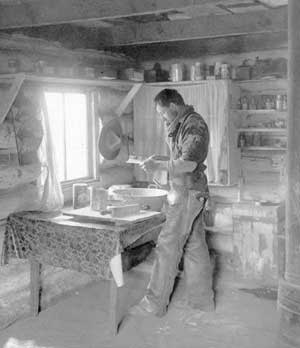Lawrence Denny Lindsley Photographs
This collection represents the landscape and nature photography of Laurence Denny Lindsley. During his career as a photographer, woodsman, wilderness guide, and miner, Lindsley took thousands of photographs of Washington State, including scenes around Mount Rainier and the Cascade Mountains, Eastern Washington, and the Pacific Ocean beaches on the Olympic Peninsula. Using a discerning eye, Lindsley captured images of extraordinary geologic formations in the Grand Coulee region, cloud formations, mountain storms, wildflowers, and historic images of steamboats and settlements around Lake Chelan. Also included are family pictures Lindsley collected of his relatives, the Denny family, one of Seattle’s earliest pioneer families. Presented here in digital format is only a selection of the more than 5000 images in the Lawrence D. Lindsley Photograph Collection.
Lawrence Denny Lindsley was born on March 18 1878 in a house overlooking Lake Union. He was the eldest grandchild of Seattle pioneers and founders, Louisa (Boren) and David T. Denny. His parents were Abbie (Denny) and Edward L. Denny. As a child and young adult, he grew up in the “great outdoors.” Lindsley spent a lot of time at his grandfather’s side, learning to hunt deer on the summit of Queen Anne Hill in Seattle, and cultivating a woodsman’s keen power of observation and an artist’s appreciation for nature. He took up photography at an early age, and later, combined it with work as a miner, trail guide, and naturalist.
In 1895, Lindsley went to work in the Esther mines near Gold Creek in the Snoqualmie Pass area. In 1899, he assisted his grandfather, Denny, who was contracted by King County to improve the existing wagon road along Lake Keechelus. Lindsley was not fond of the mining life and the labor it entailed: building cabins, drilling and hammering, and packing out ore by an arduous journey across Snoqualmie Pass to Seattle. Even so, he describes his excitement at getting up in the middle of a night storm to photograph images of "lightning rumbling against the mountains."
Lindsley became a charter member of the Mountaineers in 1907. He went to work for the W. P. Romans Photographic Studio in Seattle in 1903, and owned part interest in the studio when it was bought by Asahel Curtis in 1910. This association led him to work with Edward Curtis, for whom Lindsley developed some of the color negatives, “the gold tones,” for Curtis’s famous "Indians of North America" series.
In about 1912, Lindsley moved to his parents’ ranch along 25 Mile Creek at Lake Chelan. In 1916, he was employed by the Great Northern Railroad to photograph Glacier National Park for the railroad’s tourist literature. He also began his extensive photographic study of Lake Chelan and the coulees of Central Washington, often photographing the landscape on horseback while hand-holding a tripod. In these Chelan years and later, Lindsley worked as a guide, leading parties along the lake and into the Stehekin wilderness. Also in 1916, the railroad sent him as a guide for the party of Mary Roberts Rinehart, a popular author, on a packing trip through the North Cascades. In her novel, "Tenting Tonight," Lindsley figured prominently as the character”Silent Lawrie,” along with his faithful horse Peanut.
In 1916, Lindsley returned to Seattle and resumed work in the Asahel Curtis Studio. He married Pearl A. Miller in 1918, but his wife and infant daughter died in 1920. Throughout the 1920s, Lindsley worked for the Curtis Studio and continued his own landscape and nature photography. During this time, he perfected the technique of lantern slide photography. Lindsley liked to blend one frame into another, taking as many as eleven shots to capture, sequentially, cloud movements, birds nesting, or waves breaking on a shore. He mastered the blending of frames in the thousands of pictures he took of Mt. Rainier, the Lake Chelan region, and the beach at La Push, Washington. During his lifetime, Lindsley probably photographed Mount Rainier more often than any other photographer. In 1933, when the Washington State Federation of Garden Clubs was formed, his lantern slide lectures became a favorite among members of the garden clubs. Lindsley continued to use colored lantern slides throughout his career.
Lindsley married for a second time in 1944. He and his wife, Sarah Sonju, a color artist, created many photographic works of art from the shop in their Wallingford home in Seattle until her death in 1960. Unable to support himself solely by photography, Lindsley supplemented his income by selling postcards, prints, slides and murals, but also by renting rooms of his home to boarders, and finding odd jobs as he could, including a stint as night watchman in the 1950s. Lindsley continued to photograph into his 90s, always with an eye toward his next project. He died at home at age 96, on January 3, 1975.
About the Database
The Lawrence Denny Lindsley Photographs database was produced partially by funding from the Olympic Peninsula Virtual Community Museum project. The information for the collection was researched and prepared by the grant staff, UW Libraries Special Collections and Cataloging staff in 2005-6. Only selected photographs were included in this database. The images were scanned in grayscale using Microtek scanners and saved in .jpg format. Some manipulation of the images was done to present the clearest possible digital image. The scanned images were then linked with descriptive data using the UW ContentDM program. The original collection resides in the UW Libraries Special Collections Division as the Lawrence Denny Lindsley Photographs PH Coll 548.


